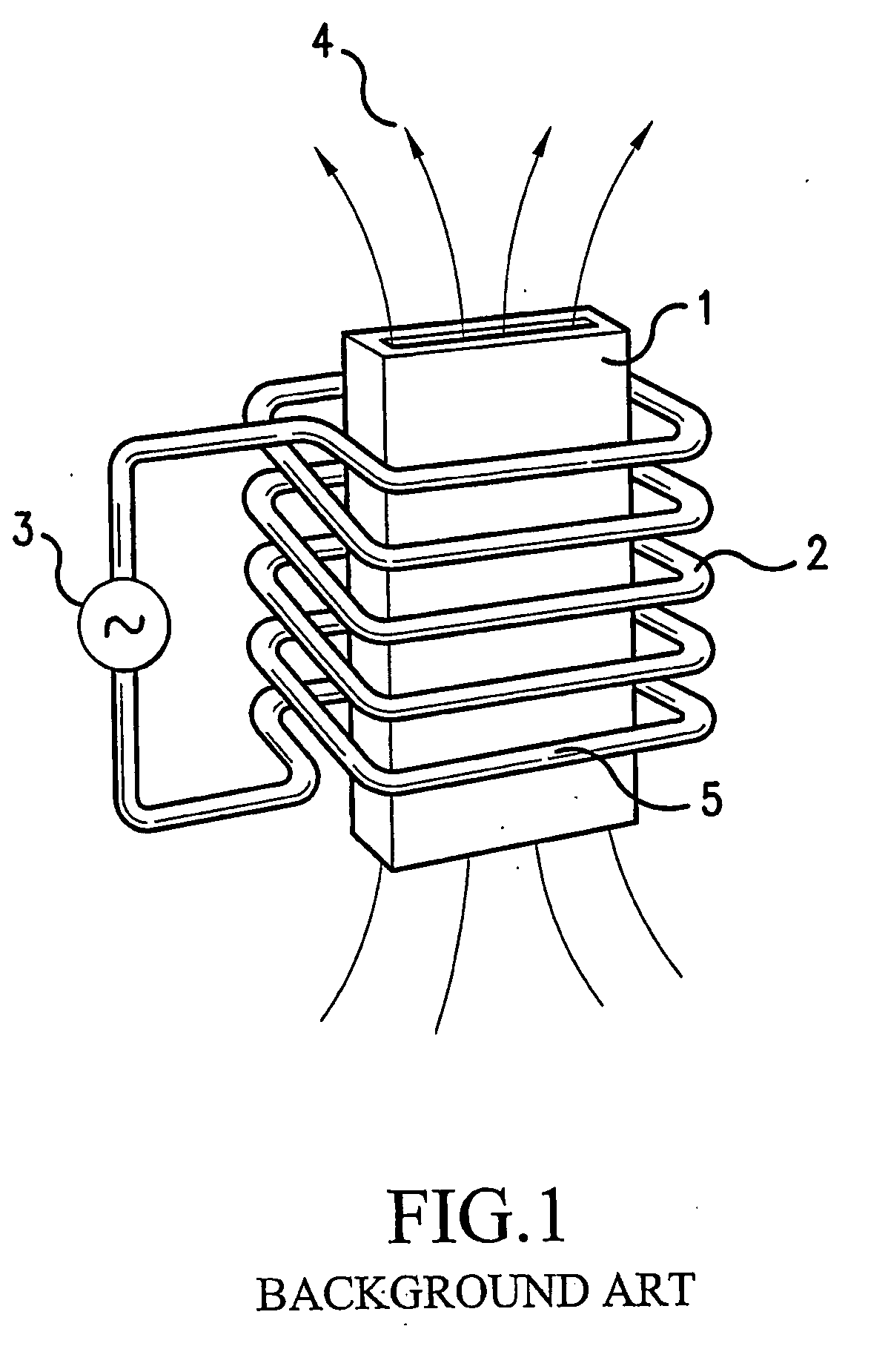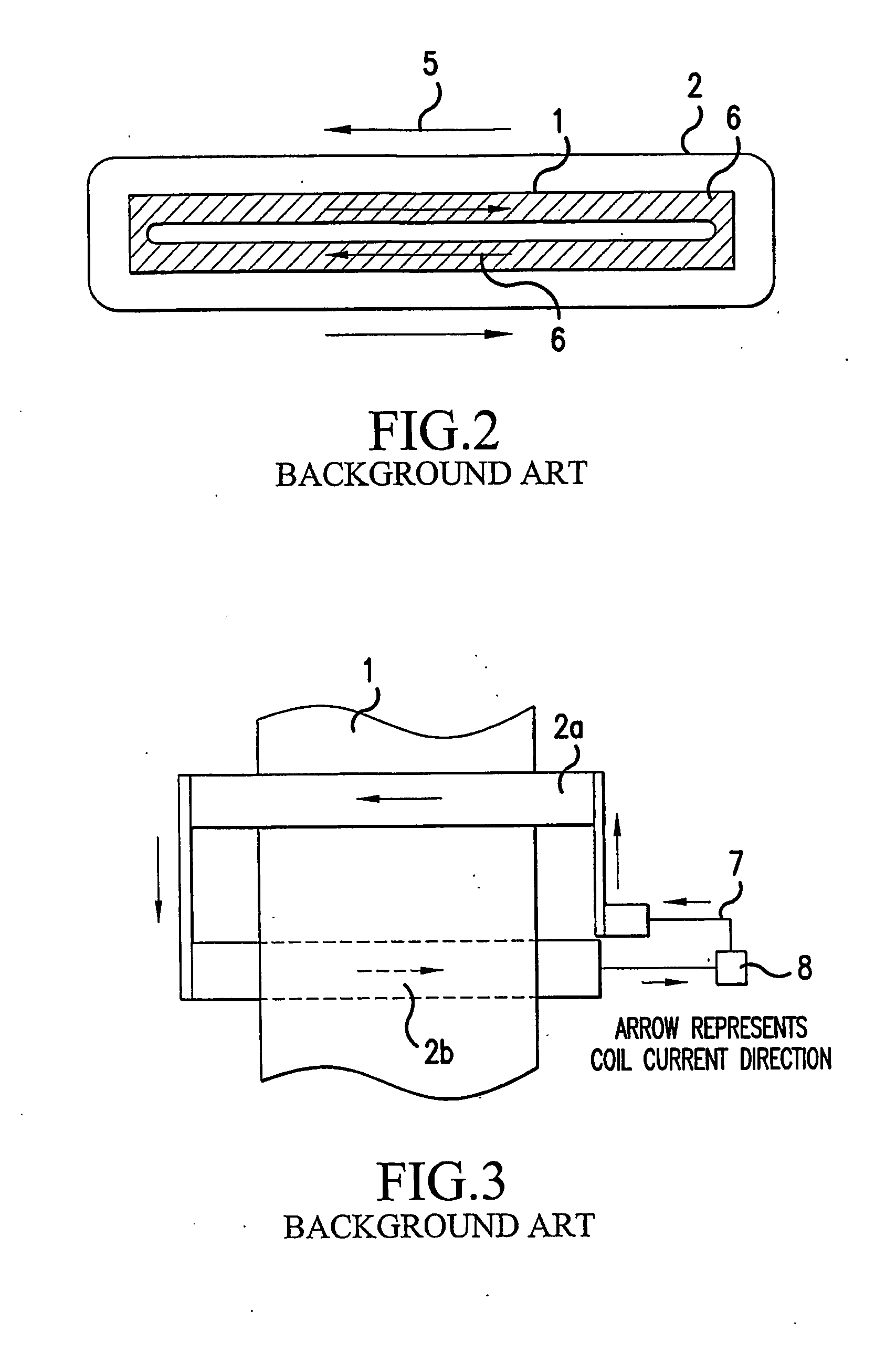Induction Heating Device for a Metal Plate
a technology of induction heating and metal plates, which is applied in the direction of electric/magnetic/electromagnetic heating, induction heating, electrical apparatus, etc., can solve the problems of non-uniform temperature distribution in a lateral direction, difficult to provide a uniform heating, and metal plate heating, etc., to achieve the effect of low specific resistance, easy to realize desired temperature distribution, and high efficiency
- Summary
- Abstract
- Description
- Claims
- Application Information
AI Technical Summary
Benefits of technology
Problems solved by technology
Method used
Image
Examples
embodiment 1
[0102]A heating test of the present invention was carried out with a metal plate made of non-magnetic SUS304 steel plate (thickness: 0.2 mm, width: 600 mm). The test will be described with reference to FIGS. 27A and 27B. The AC power supply (not shown) was 25 KHz, and a capacitor having a 100 KW capacitance was adjusted to match the induction coil to be used. The induction coil used was a single turn (surrounding the steel plate to be heated) induction coil. A water-cooled copper plate was constructed of a copper plate having a thickness of 5 mm and a width of 100 mm (different from a width defined for the present invention). A water-cooling copper tube (outer diameter: 10 mm, inner diameter: 8 mm) was attached to the copper plate on the side (outer side) opposite to the steel plate by brazing. In this example, the “induction coil” included both a copper plate and a water-cooling copper tube, since the electric current also runs through the copper tube. A gap between the steel plate...
embodiment 2
[0108]A heating test of the present invention was also carried out with respect to a cold rolled steel plate (thickness: 0.6 mm, width: 600 mm). The AC power supply (not shown) was 50 KHz, and a capacitor having a 200 KW capacitance was adjusted to match the induction coil to be used. The traveling speed of the steel plate was 2 m / min.
[0109]An induction coil shown in FIG. 28 was used for the test, where the AC power supply and the connection to the power supply are not shown. In FIG. 28, an upper induction coil includes a plurality of induction coil conductors A-J, each of which is made of a water-cooled copper plate (width: 50 mm, thickness: 10 mm) insulated and independent from each other and placed obliquely to the transverse direction of the steel plate to be heated (referred to as “the oblique induction coil conductors A-J”). Similarly, a lower induction coil includes a plurality of induction coil conductors K-T. Each of the induction coil conductors A-J of the upper induction ...
embodiment 3
[0117]An induction heating apparatus as shown in FIG. 17 or FIG. 18, both the upper and the lower induction coils have oblique portions which are located on the same side in the longitudinal direction of the metal plate to the transverse line of the metal plate and are roughly parallel to each other. Such an induction heating apparatus is used for heating metal plates having different widths. The same induction coil and the same AC power supply as in the above-described embodiment 1 were used, except for the oblique portion angle direction of the induction coil. The metal plates used were SUS304 steel plates having a 0.4 mm thickness and a width 800 mm and a width 600 mm. The traveling speed of the steel plate was 2 m / min. The gap between the steel plate and the induction coil was 50 mm.
[0118]In Examples M and N, a distance between the upper and lower induction coils was set to 200 mm in the central area, and a distance at the edge area when an 800 mm steel plate was used was 170 mm...
PUM
 Login to View More
Login to View More Abstract
Description
Claims
Application Information
 Login to View More
Login to View More - R&D
- Intellectual Property
- Life Sciences
- Materials
- Tech Scout
- Unparalleled Data Quality
- Higher Quality Content
- 60% Fewer Hallucinations
Browse by: Latest US Patents, China's latest patents, Technical Efficacy Thesaurus, Application Domain, Technology Topic, Popular Technical Reports.
© 2025 PatSnap. All rights reserved.Legal|Privacy policy|Modern Slavery Act Transparency Statement|Sitemap|About US| Contact US: help@patsnap.com



